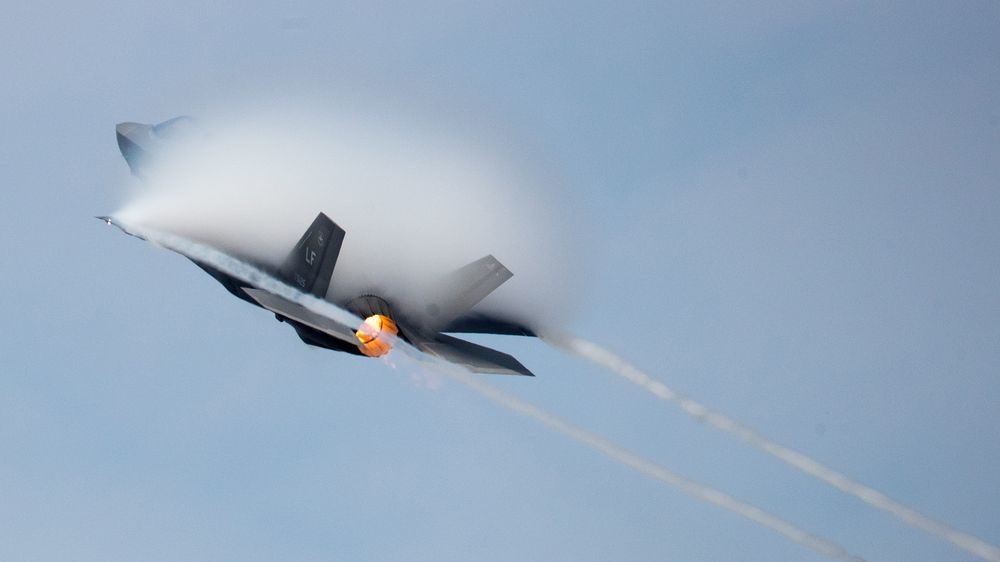
© Matt Cardy/Getty ImagesF-35A Lightning II
's F-35 jet, the world's costliest weapons program, just got even costlier.
The estimated total price for research and procurement has increased by
$22 billion in current dollars adjusted for inflation, according to the Pentagon's latest annual cost assessment of major projects. The estimate for
operating and supporting the fleet of fighters over more than six decades grew by almost $73 billion to $1.196 trillion.The increase to $428.4 billion from $406.2 billion in acquisition costs, about a 5.5 percent increase,
isn't due to poor performance, delays or excessive costs for labor or materials, according to the Defense Department's latest Selected Acquisition Report sent to Congress last week and obtained by Bloomberg News.
Instead, the increase reflects for the first time the current cost estimates for
a major set of upgrades planned in coming "Block 4" modifications, according to the report.
"Ensuring our Block 4 efforts are captured in our acquisition baseline and now in our SAR help us to provide full transparency and status on our F-35 modernization progress," the Pentagon's F-35 program office said in an emailed statement.
"The F-35 program
remains within all cost, schedule and performance thresholds and continues to make steady progress," the program office said in its statement. The office "is committed to the delivery of cost-effective warfighting capability across all areas of the program."
But the long-range cost estimate for operating the fleet from 2011 to 2077 was problematic even before the latest independent Pentagon cost projection of an increase to $1.196 trillion. By contrast, the F-35 program office's latest estimate declined by about $8.5 billion to $1 trillion.
Scrutiny ExpectedThe projected increase is likely to be scrutinized by lawmakers, Pentagon acquisition chief Ellen Lord and Acting Defense Secretary Pat Shanahan because they have been pushing the program office and Lockheed to reduce projected operations and support costs.
As a potential sign of concern,
the Pentagon's fiscal 2021 proposed budget calls for 17 fewer F-35s than planned -- 81, according to the Selected Acquisition Report.
"At current estimates, the projected F-35 sustainment outlays based upon given planned fleet growth will strain future service operations and support budgets," the report said. Lockheed also "must embrace much-needed supply chain management affordability initiatives, optimize priorities across the supply chain for spare and new production parts" and share the data rights to certain F-35 software with the Pentagon.
Lockheed's ViewCarolyn Nelson, a spokeswoman for Bethesda, Maryland-based Lockheed, said in an email that the contractor "is taking aggressive action to build supply chain capacity, reduce supply chain costs and improve parts availability to help drive sustainment costs down while enhancing readiness."
She said the actions by the No. 1 U.S. defense contractor include supply chain competitions, restructuring supplier contracts, synchronizing spare buys, improving parts reliability and accelerating modifications to earlier aircraft. Likewise, the company has "reduced our portion of 'cost per aircraft' per year by 15 percent since 2015 and we continue to look for ways to reduce costs," she said.
The U.S. still plans to buy 2,456 total of the jets in its variations: 1,763 for the Air Force, 420 for the Marines and 273 for the Navy. The totals don't include more than 700 potential foreign military sales.
Speed of NegotiationsThe Pentagon report urged better cooperation from Lockheed to speed contract negotiations as the pace of F-35 production ramps up.
Talks for the 12th and largest production contract to date, valued at as much as $22 billion, have moved quickly and are on track to finish in mid-May. But that hasn't always been the case.
The Pentagon F-35 program office "continues to experience slow negotiation behaviors from the prime contractor that unnecessarily extends the timeline to contract award," the report found.Nelson said "we continue to negotiate in good faith" and in the current talks "used the actual data from the last 11 contracts as the basis of our offer."
Comment: It's no secret thtat the Pentagon is overseeing "astonishing fraud", one way it does this is by stashing billions in funding, only to spend it later, thus avoiding accountability, and it seems the F-35 project is no different. It's also no wonder the Pentagon failed its first ever audit, even after changing the accountancy rules: "accuracy" problems in $2.7 trillion organization
See also: